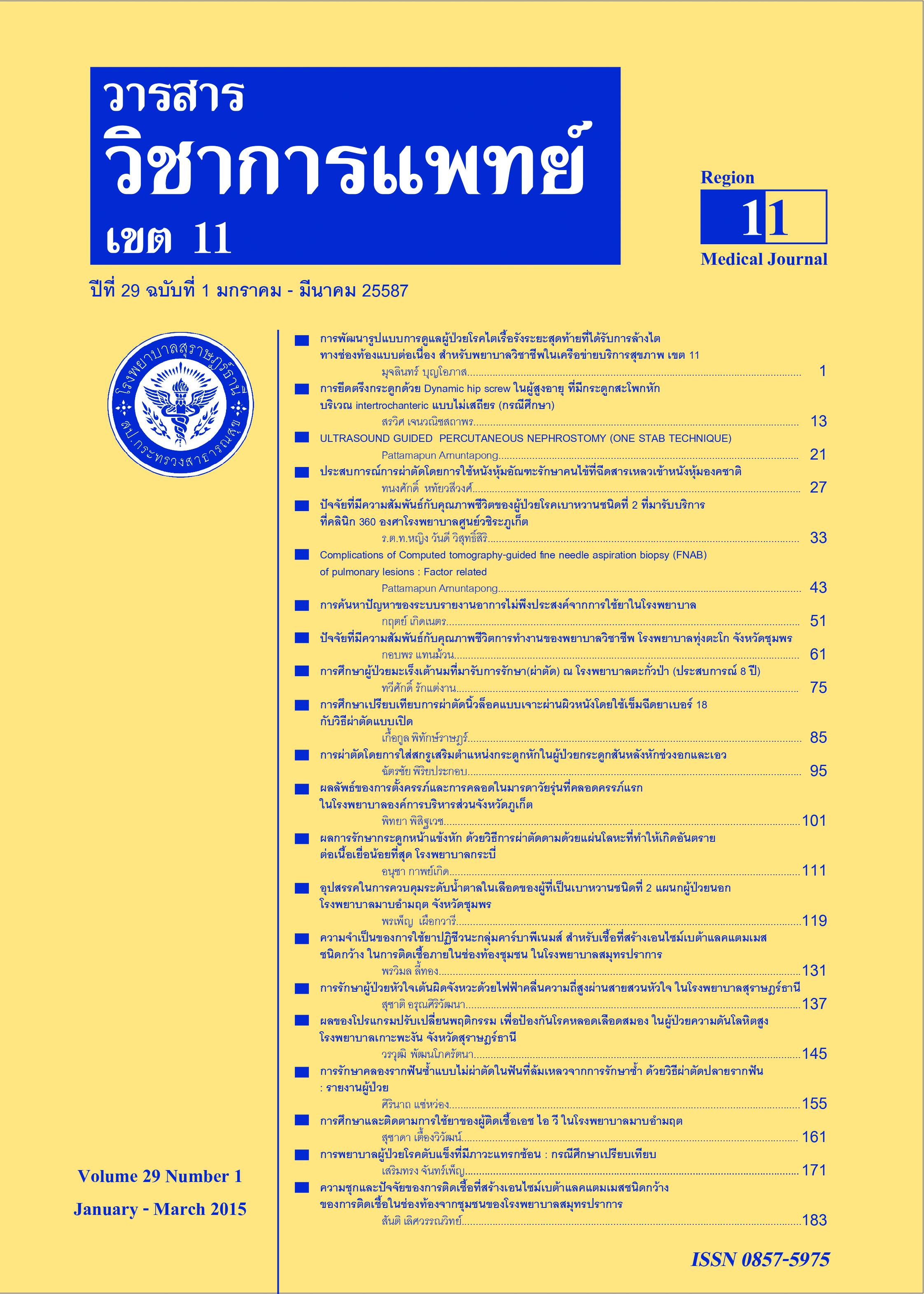The development of a caring model for patients with end-stage renal disease on continuous ambulatory peritoneal dialysis by registered nurses in region 11,s health care network
Keywords:
Research and development, Caring model for patients with end-stage renal disease, Continuous ambulatory peritoneal dialysisAbstract
The purpose of this research and development was to develop a caring model for patients with end-stage renal disease on continuous ambulatory peritoneal dialysis by registered nurses in region 11,s health care network. This study used system theory as the framework. The timeframe was from November till February 2015. The purposive sampling method used in this study was split into two groups. The first group was 14 nurses who work at the renal clinic and dialysis. The second group was 60 patients with end-stage renal disease on continuous ambulatory peritoneal dialysis. Both groups were located
at provincial hospitals in region 11’s health care network. The tool of this study consists of six types. The first is the caring model for patients with end-stage renal disease on continuous ambulatory peritoneal dialysis. The second is the questionnaire asking for general information and the appropriate model by nurses. The third is the questionnaire for nurses asking whether their practice follows the caring model. The fourth is a questionnaire to measure the patients’ perception of their self care. The fifth is a questionnaire that asks about patients’ self care behavior. The sixth is the patient care record. The process of the research consists of three steps. Firstly, the development of the caring model. Secondly, use of the caring model. Thirdly, evaluation of the outcome from this
model. The data analysis used frequency percentage, standard deviation, and a paired t test.
This study showed the results of a caring model for patients with end-stage renal disease on continuous ambulatory peritoneal dialysis by registered nurses. It consisted of 13 components: 1) counseling before continual ambulatory peritoneal dialysis 2) preparation of patient and family before treatment
3) caring for the patient in the initial stage of continual ambulatory peritoneal dialysis 4) continued care after initial setup 5) keeping a record of dialysis
6) nutrition 7) daily activities 8) meeting doctor before follow up 9) continuous nursing care 10) home care 11) peritoneal equilibration test 12) dialysis adequacy 13) referring patients.
The evaluations of this model of care by 14 registered nurses found that every component was suitable. Daily activities was particularly suitable (X=4.5, SD=0.65). The evaluation of the model with patients, 60 patients with perceived self-care and self-care behavior in nutrition, medications and peritoneal dialysis increased significantly statistically (p. <0.01) They also found that the incidence of complications such as peritoneal infection and volume overload after the model was reduced to 10.00 % and 2.10 % respectively.
References
2. เกื้อเกียรติ ประดิษฐ์พรศิลป์. ข้อมูลการรักษาทดแทนไตด้วย CAPD ในประเทศไทย. ในสมชายเอี่ยมอ่องและคณะ (บรรณาธิการ), Textbook of Peritoneal Dialysis.กรุงเทพฯ : เท็กซ์แอนด์เจอร์นัลพับลิเคชั่น จำกัด ; 2551.
3. เกื้อเกียรติ ประดิษฐ์พรศิลป์. ข้อมูลการรักษาทดแทนไตด้วย CAPD ในประเทศไทย. URL http://www.kdf.nhso.go.th ; 20 ตุลาคม 2557.
4. กาญจนา รัตนะ. การปรับปรุงคุณภาพงานบริการ CAPD. เอกสารประชุมวิชาการสมาคมโรคไตแห่งประเทศไทย.กรุงเทพ; 2554 : 13-34.
5. สำนักงานหลักประกันสุขภาพแห่งชาติ. รายงานผลการดำเนินงานโครงการล้างไตผ่านทางช่องท้องในโครงการหลักประกันสุขภาพถ้วนหน้า (1 ตุลาคม 2556-30กันยายน2557).
URL http://www.kdf. nhso.go.th/ ;20 ตุลาคม 2557.
6. David Easton,n.d. System theory. URL http://education. illinois.edu/circe/ edpsy490e/ prestine1_new.pdf.; retrieved 10 September 2014.
7. National College of Ireland. E-Learning Research & Development Roadmap for Ireland. URL http://w w w . k n o w - 2 . n e t / k 2 d o c s / M K e l l e -
her_06-04-05_10-56-26.pdf ; retrieved 7 April 2007.
8. ทวี ศิริวงค์และคณะ. แนวทางปฏิบัติการดูแลรักษาผู้ป่วยล้างไตทางช่องท้อง ใน สมชาย เอี่ยมอ่องและคณะ (บรรณาธิการ), Textbook of Peritoneal Dialysis.กรุงเทพฯ : เท็กซ์แอนด์เจอร์นัลพับลิเคชั่น จำกัด; 2551.
9. พูลสุข หิงคานนท์. ทฤษฎีที่เกี่ยวกับการบริหารระบบบริการพยาบาล ในคณะกรรมการผลิตและบริหาร ชุดวิชา การพัฒนาศักยภาพระบบบริการพยาบาล หน่วยที่3,13. นนทบุรี :มหาวิทยาลัยสุโขทัยธรรมาธิราช ;2549.
10. จุฑาภัทร์ สุวรรณไพรัตน์. ปัจจัยที่มีอิทธิพลต่อพฤติกรรมการควบคุมระดับฟอสเฟตในเลือดของผ้ปู่วยฟอกเลือดด้วยเครื่องไตเทียม. กรุงเทพฯ: มหาวิทยาลัยมหิดล ; 2554.
11. จิราภรณ์ ชูวงศ์และ เจียมจิต โสภณสุขสถิต.ผลของการให้ความร้ทู างด้านสุขภาพต่อพฤติกรรมการดูแลตนเองของผู้ป่วยไตวายเรื้อรังที่ได้รับการฟอกเลือดด้วยเครื่องไตเทียม. วารสารวิจัยทางวิทยาศาสตร์สุขภาพ. 2554;ปีที่ 5 ฉบับที่ 2 : กรกฎาคม – ธันวาคม.
12. วนิดา คู่เคียงบุญ. การจัดการกับภาวะนำเกินในผู้ป่วยโรคไตเรื้อรัง. วิทยานิพนธ์พยาบาลศาสตรมหาบัณฑิตสาขาวิชาการพยาบาลผู้ใหญ่, บัณฑิตวิทยาลัยมหาวิทยาลัยขอนแก่น ; 2552.






